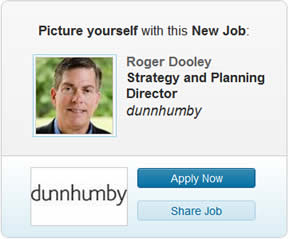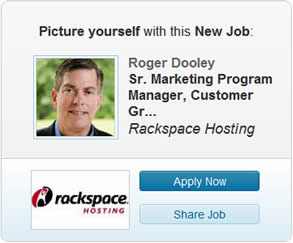Social Personalization and the Doppelganger Effect
 Are you overlooking a way to personalize your ads that goes far beyond the usual “Dear Roger” salutation?
Are you overlooking a way to personalize your ads that goes far beyond the usual “Dear Roger” salutation?
In my recent article, Put Your Customer in the Ad, I mentioned that LinkedIn was using profile pictures for targeted ads. Since then, I’ve been able to capture a couple of examples. The first one surprised me when it appeared, and to generate a second one I had to surf a variety of profiles. Here’s what I like about these ads:
Image personalization
Who could resist looking at an ad that contains their own picture? I suppose once viewers are inundated with them, they’ll be less effective, but for now it’s hard to imagine more eye-catching content. And I think even as these ads become more common they’ll be as attention getting as the often-used images of weird looking guys, weirder looking guys, or bikini babes. While including an irrelevant but eye-catching image may grab the viewer’s attention and garner more clicks (if these ads didn’t work, we wouldn’t see so many of them!), it does nothing positive for the brand.
The Doppelganger Effect
 In my earlier post, I described research that showed even crude representations of a viewer using a brand (created by superimposing an image of the viewer’s head onto a picture of a person drinking a soft drink) created a preference for the brand being consumed. The researchers dubbed the composite image a “virtual doppelganger,” from a German word that refers to a person’s “ghostly double.”
In my earlier post, I described research that showed even crude representations of a viewer using a brand (created by superimposing an image of the viewer’s head onto a picture of a person drinking a soft drink) created a preference for the brand being consumed. The researchers dubbed the composite image a “virtual doppelganger,” from a German word that refers to a person’s “ghostly double.”
The LinkedIn ads may not fully create a virtual doppelganger, but they do help the viewer visualize himself/herself as part of the company. First, the text reads, “Picture yourself…” Then, next to the photo, the viewer’s name and “title” appear, almost in business card format. (Presumably, the title is based on an actual opportunity, though I didn’t attempt to verify that. It would be a letdown to see my name and “Chief Marketing Officer” only to contact the firm and find they were recruiting assistant managers.)
The important factor here is that even contrived visualization of this sort can create a preference.
Targeting
Based on my experience in trying to trigger these highly personalized ads, they are well-targeted. I noticed several layers of targeting, though with LinkedIn’s detailed profiles they could no doubt target in many more ways (and perhaps do). First, I saw ads from companies whose profiles I visited, a good indicator of interest and, perhaps, familiarity. An advertiser might want to cast a wider net, but this approach certainly offers a high click probability.
The next layer of targeting was the type of position advertised, which in my examples are reasonably well-matched to my profile. This is really important – the right title could get clicks even from visitors not engaged in a job search. The wrong title would at best perform poorly and at worst actually damage the advertiser’s image. Imagine, for example, a Fortune 500 CTO who sees a keyword-triggered ad that says, “Picture yourself as a Network Support Specialist!” I’m sure gaffes like this occur, particularly for individuals with vague or uncommon titles, but LinkedIn has put some thought into this.
Improvements
These ads are simple, but I can think of at least one tweak that would amp up the doppelgänger effect. What if the ad was modified slightly so as to simulate an actual business card with company logo, name, title, photo, etc.? A minor change, but one that would add to the reality of the visualization.
Get socialized!
Overall, this modest use of a photo and profile data should greatly increase the effectiveness of these career ads. I would expect them to deliver two main benefits:
- Increased attention and click through rates
- A small lift in company preference
Note that while LinkedIn has direct access to their user profile data, tools are available that let you get the same kind of information when users “connect” with your site or app using Facebook, Twitter, etc.
[Next in the series: How Higher Ed Uses Social Personalization.]
